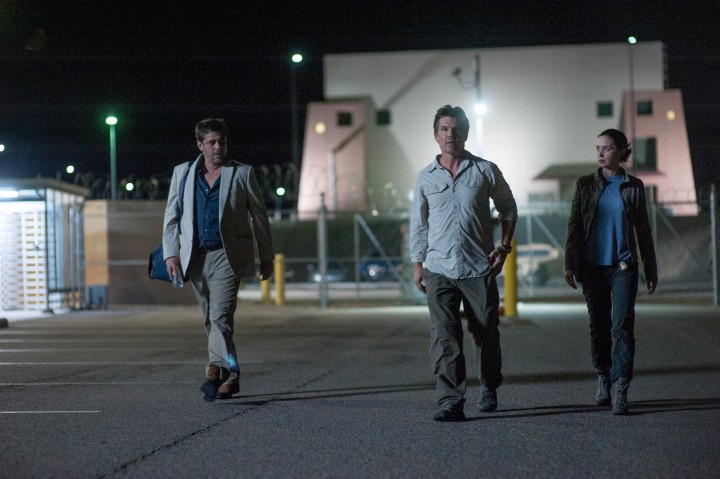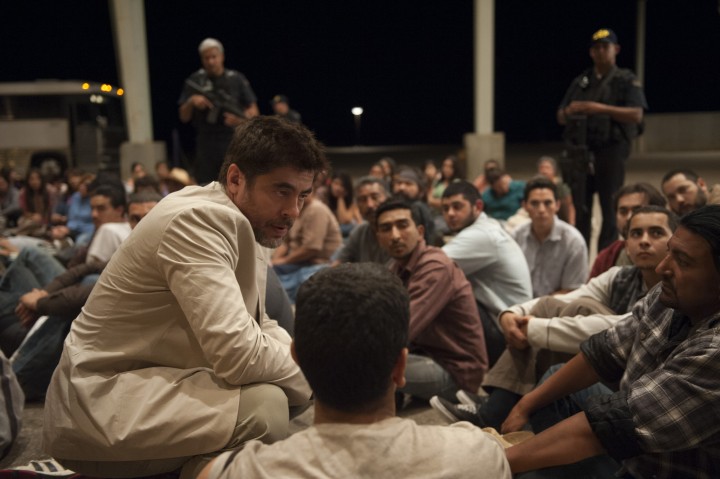“There is an imaginary line out there between right and wrong, good and evil. I believe what I am doing is good and what I am standing against is evil,” claims Tim Foley, leader of paramilitary group Arizona Border Recon in Matthew Heineman’s troubling documentary “Cartel Land.” His words echo throughout director Denis Villeneuve’s and screenwriter Taylor Sheridan’s tense and brutal thriller “Sicario.” But not only does that imaginary line keep shifting throughout the film, it’s completely obliterated by the end. Foley may be fighting an imaginary war of his own, blaming the government for not doing enough; but for the government-sanctioned operation at the center of this drama, the war is real. “Sicario” may be a work of fiction but the questions it raises about the price we pay in fighting this or any other war are as relevant and thought-provoking as any raised by any talking head or opinion columnist.
As the film opens, an armored vehicle transporting FBI agent Karen Macer (Emily Blunt) and her kidnap-response team smashes into a suburban safe house outside Chandler, Arizona to rescue an unknown number of hostages from a gang linked to cartel honcho and “respectable” Arizona businessman Manuel Díaz. Instead, they find 42 bodies hidden behind the house’s drywall, all tortured and strangled, their heads wrapped in plastic. Add a booby trap that maims and kills a couple of law enforcement agents and you soon have politicians and bloviators screaming bloody hell. How could this happen in American soil?
Kate “volunteers” to be part of a government task force led by two consultants: cynical operative Matt Graver (Josh Brolin) and the more taciturn Alejandro (Benicio del Toro), a former prosecutor. Kate believes in the rule of law, that you need to follow procedure in order to bring these drug lords to justice. When she asks Matt what their objective is, he replies “to dramatically overreact.” In other words, let’s bring the war to them.
Kate’s first mission with the outfit takes her to Juárez to pick up Díaz’s brother from a local jail and bring him back to the United States. The sequence ends in one of the year’s most suspenseful action sequences as, stuck in traffic in the U.S.-Mexico border with their prisoner inside one of their black S.U.V.s, the team prepares for a potential ambush as they identify potential shooters in each car surrounding them. The inevitable gun battle is swift, brutal and almost personal as Alejandro jumps into action, revealing that there is more to this prosecutor than meets the eye.
Back in Arizona, Matt and Alejandro insist on keeping Kate in the dark about their actual plans. She’s there for a reason, one that has absolutely nothing to do with her particular set of skills. She is just another pawn in a barely legal game of gotcha, one that involves torture and a trip through one of the many underground tunnels that criss cross the border. With its use of two different types of night vision lenses, Villeneuve and director of photography Roger Deakins deliver another frightful action sequence that keeps much of the violence off-camera.
Kate is our proxy, our conscience, throughout the first half of the film. She voices our doubts about the tactics employed. But neither Villeneuve nor Sheridan are interested in easy moralizing; they are more interested in showing the toll this war takes on its combatants, on the price good people pay when they are caught in the middle of it. And so, slowly, subtly, the film shifts its focus from Kate to Alejandro, a man who lost his moral compass a long time ago. The movie takes him, and us, to a point of no return, to an encounter that proves to be as devastating, as brutal, as anything we have seen so far.
From the flawed Mexican cop of “Traffic” to the sadistic murderer Lado in”Savages,” Oliver Stone’s egregiously self-important take on the drug war, Benicio Del Toro has been our cinematic guide to the complex and devastating world of drug trafficking. In “Sicario” he delivers his most understated performance yet, one in which he lets his body, his eyes, his silences do most of the talking. His Alejandro could turn on you in a moment, a man who only feels empathy towards those poor men and women caught in the middle, like the undocumented immigrants he quietly interrogates on a bus depot. And even then, they could find themselves with a gun pointing towards them.
Brolin delivers an unsettling performance as Matt, providing a healthy dose of I-don’t-give-a-damn dark humor to the proceedings. Blunt’s commanding presence is, as her character, eventually overpowered by these two Alpha males.
Roger Deakins’ unnervingly beautiful photography and composer Jóhan Jóhansson’s eerie score should share equal billing with the lead actors. Deakins has created images that are sharp and strange and astounding with his Arri Alexa: an airplane’s small shadow as it crosses the border’s rugged terrain, dusk silhouetting the operatives that are about to enter the underground tunnel; even dust particles floating as sunlight shines into a room. Such beauty heightens the horror we feel as we watch this world reveal itself in front of us. Jóhansson’s score feels almost Sigur Ros-esque in its use of slow droning sounds that suddenly crescendo into an explosion of rhythms and clashing beats. But silence plays a fundamental role in this film as well: its eerie, natural presence prepares us for what’s to come while offering a moment of brief respite amidst the maelstrom. It’s in these quiet moments when the film comes alive in horrendous wonder.

